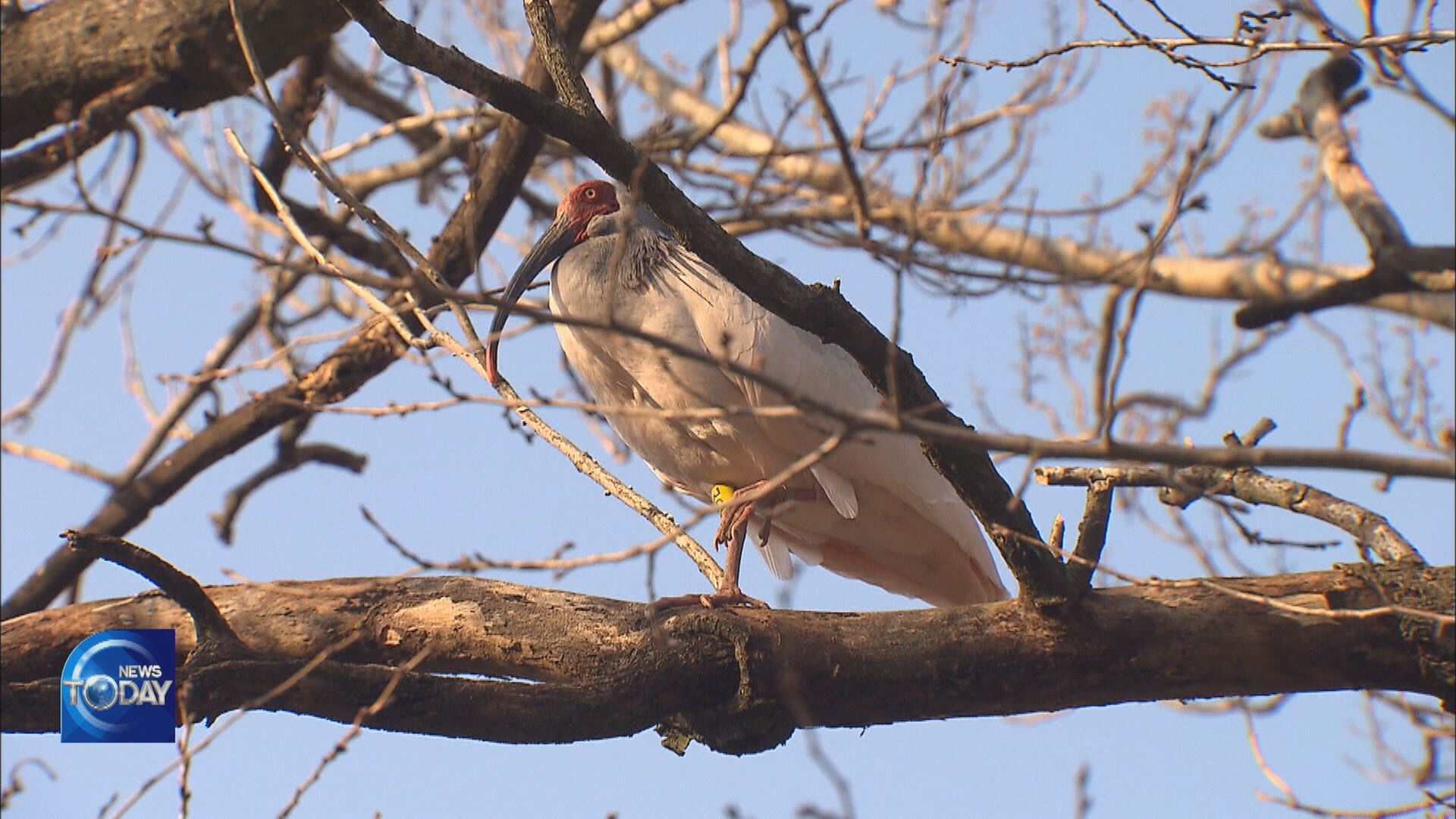CRESTED IBISES GIVE BIRTH IN THE WILD
입력 2021.04.30 (15:11)
수정 2021.04.30 (16:46)
읽어주기 기능은 크롬기반의
브라우저에서만 사용하실 수 있습니다.
[Anchor Lead]
Crested ibises often appear in Korean children's songs. The birds were spotted in the country last time in 1979. A pair of crested ibises was brought to Korea from China in 2008. For the first time in 12 years crested ibises have had their young in the wild in Korea.
[Pkg]
A mountain in Changnyeong County, Gyeongsangnam-do Province. In a large nest built on the branches of a tall pine tree, a mother ibis feeds her young. A pair of six-year-old crested ibises built their first nest a month ago. The mother bird laid three eggs on March 27, 29 and 31. Two of them hatched. The crested ibis was last spotted in Korea in the DMZ in 1979. To protect the birds from wildcats, the government of Changnyeong County installed a safety device and a surveillance camera near the nest to monitor it around the clock. A 6ha habitat has also been created in the area frequented by the birds to help them settle down in the wild.
[Soundbite] Lee Sung-bong(Changnyeong-gun County Gov’t) : "In many cases we couldn't track their location. Our staff checked on the birds in person. We have more than 300 monitoring staff members now."
Locals also contributed to protecting the rare bird species.
[Soundbite] Jeon Kap-saeng(Local resident) : "We try to minimize the use of pesticides in nearby paddies and fields."
The restoration of crested ibises began in Korea in 2008 when a pair was brought from China as a symbol of friendship between the two nations. Since then, the population of crested ibises has grown to more than 430. Next month, 40 more birds will be released to the wild.
Crested ibises often appear in Korean children's songs. The birds were spotted in the country last time in 1979. A pair of crested ibises was brought to Korea from China in 2008. For the first time in 12 years crested ibises have had their young in the wild in Korea.
[Pkg]
A mountain in Changnyeong County, Gyeongsangnam-do Province. In a large nest built on the branches of a tall pine tree, a mother ibis feeds her young. A pair of six-year-old crested ibises built their first nest a month ago. The mother bird laid three eggs on March 27, 29 and 31. Two of them hatched. The crested ibis was last spotted in Korea in the DMZ in 1979. To protect the birds from wildcats, the government of Changnyeong County installed a safety device and a surveillance camera near the nest to monitor it around the clock. A 6ha habitat has also been created in the area frequented by the birds to help them settle down in the wild.
[Soundbite] Lee Sung-bong(Changnyeong-gun County Gov’t) : "In many cases we couldn't track their location. Our staff checked on the birds in person. We have more than 300 monitoring staff members now."
Locals also contributed to protecting the rare bird species.
[Soundbite] Jeon Kap-saeng(Local resident) : "We try to minimize the use of pesticides in nearby paddies and fields."
The restoration of crested ibises began in Korea in 2008 when a pair was brought from China as a symbol of friendship between the two nations. Since then, the population of crested ibises has grown to more than 430. Next month, 40 more birds will be released to the wild.
■ 제보하기
▷ 카카오톡 : 'KBS제보' 검색, 채널 추가
▷ 전화 : 02-781-1234, 4444
▷ 이메일 : kbs1234@kbs.co.kr
▷ 유튜브, 네이버, 카카오에서도 KBS뉴스를 구독해주세요!
- CRESTED IBISES GIVE BIRTH IN THE WILD
-
- 입력 2021-04-30 15:11:30
- 수정2021-04-30 16:46:05

[Anchor Lead]
Crested ibises often appear in Korean children's songs. The birds were spotted in the country last time in 1979. A pair of crested ibises was brought to Korea from China in 2008. For the first time in 12 years crested ibises have had their young in the wild in Korea.
[Pkg]
A mountain in Changnyeong County, Gyeongsangnam-do Province. In a large nest built on the branches of a tall pine tree, a mother ibis feeds her young. A pair of six-year-old crested ibises built their first nest a month ago. The mother bird laid three eggs on March 27, 29 and 31. Two of them hatched. The crested ibis was last spotted in Korea in the DMZ in 1979. To protect the birds from wildcats, the government of Changnyeong County installed a safety device and a surveillance camera near the nest to monitor it around the clock. A 6ha habitat has also been created in the area frequented by the birds to help them settle down in the wild.
[Soundbite] Lee Sung-bong(Changnyeong-gun County Gov’t) : "In many cases we couldn't track their location. Our staff checked on the birds in person. We have more than 300 monitoring staff members now."
Locals also contributed to protecting the rare bird species.
[Soundbite] Jeon Kap-saeng(Local resident) : "We try to minimize the use of pesticides in nearby paddies and fields."
The restoration of crested ibises began in Korea in 2008 when a pair was brought from China as a symbol of friendship between the two nations. Since then, the population of crested ibises has grown to more than 430. Next month, 40 more birds will be released to the wild.
Crested ibises often appear in Korean children's songs. The birds were spotted in the country last time in 1979. A pair of crested ibises was brought to Korea from China in 2008. For the first time in 12 years crested ibises have had their young in the wild in Korea.
[Pkg]
A mountain in Changnyeong County, Gyeongsangnam-do Province. In a large nest built on the branches of a tall pine tree, a mother ibis feeds her young. A pair of six-year-old crested ibises built their first nest a month ago. The mother bird laid three eggs on March 27, 29 and 31. Two of them hatched. The crested ibis was last spotted in Korea in the DMZ in 1979. To protect the birds from wildcats, the government of Changnyeong County installed a safety device and a surveillance camera near the nest to monitor it around the clock. A 6ha habitat has also been created in the area frequented by the birds to help them settle down in the wild.
[Soundbite] Lee Sung-bong(Changnyeong-gun County Gov’t) : "In many cases we couldn't track their location. Our staff checked on the birds in person. We have more than 300 monitoring staff members now."
Locals also contributed to protecting the rare bird species.
[Soundbite] Jeon Kap-saeng(Local resident) : "We try to minimize the use of pesticides in nearby paddies and fields."
The restoration of crested ibises began in Korea in 2008 when a pair was brought from China as a symbol of friendship between the two nations. Since then, the population of crested ibises has grown to more than 430. Next month, 40 more birds will be released to the wild.
이 기사가 좋으셨다면
-
좋아요
0
-
응원해요
0
-
후속 원해요
0












![[영상] “비상계엄 사과할 생각은?” 질문에<br> 윤 전 대통령 ‘묵묵부답’](/data/fckeditor/vod/2025/05/12/320341747047877811.png)




이 기사에 대한 의견을 남겨주세요.